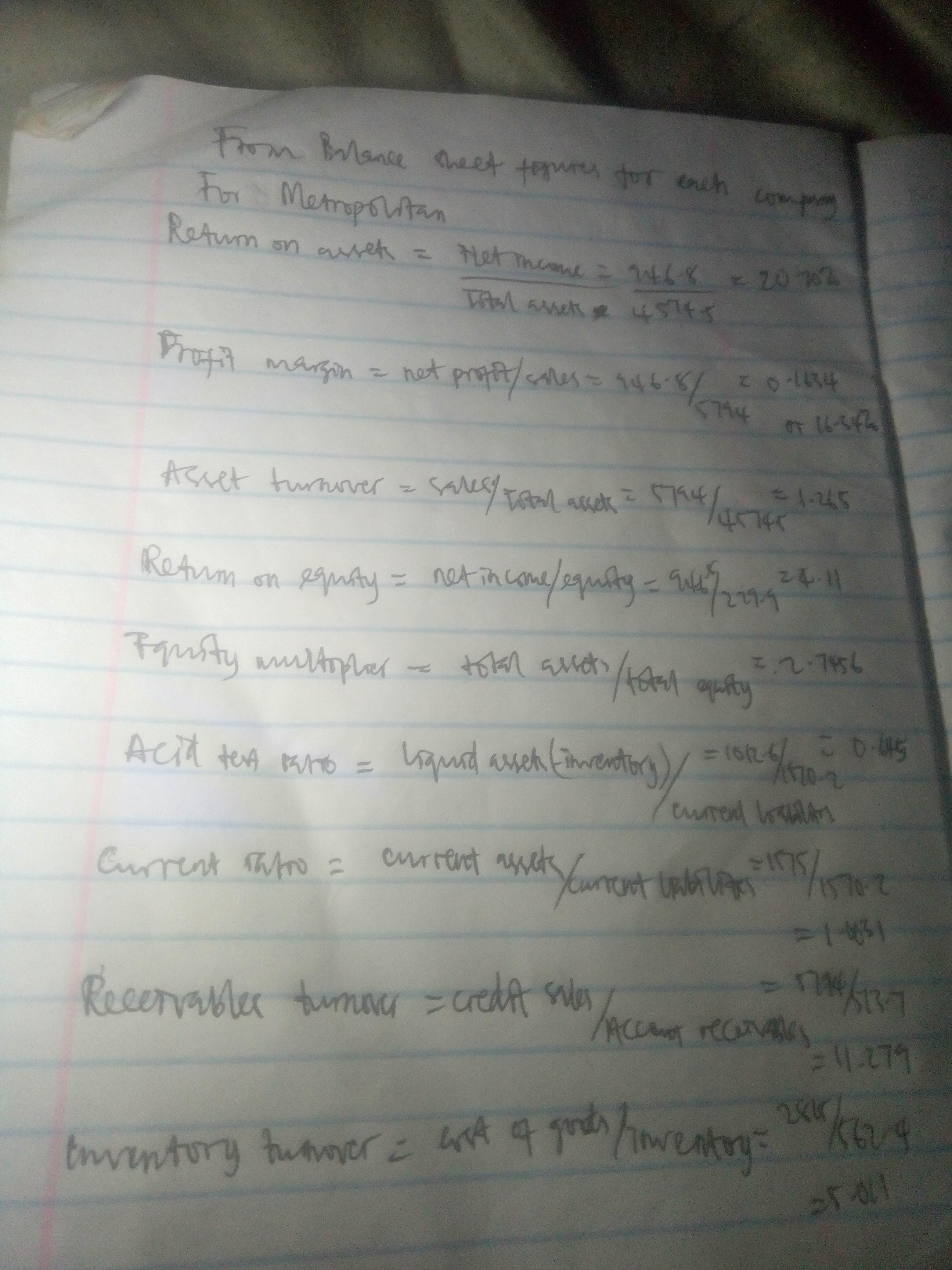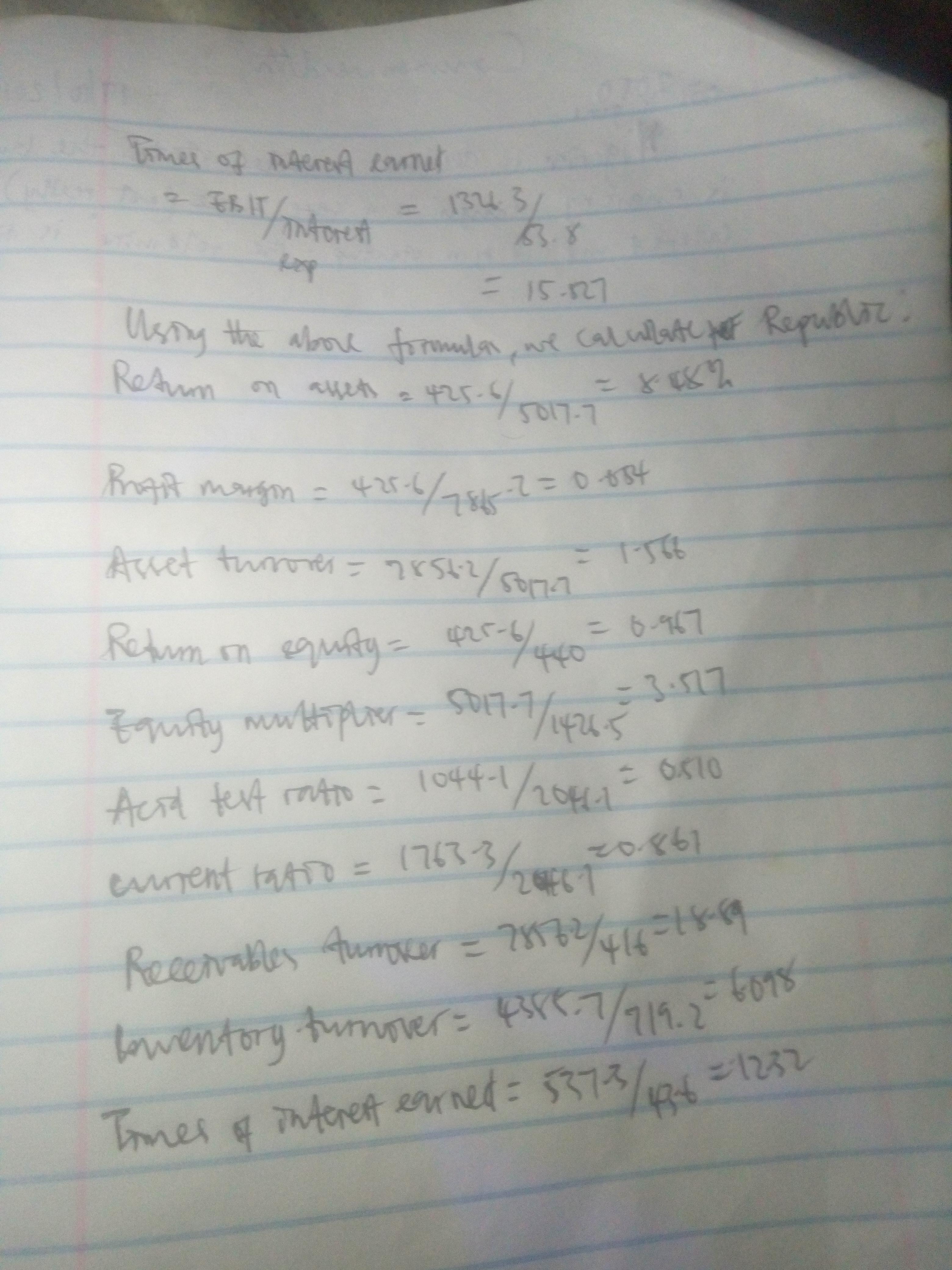Presented below are condensed financial statements adapted from those of two actual companies competing as the primary players in a specialty area of the food manufacturing and distribution industry. ($ in millions, except per share amounts.)
Balance Sheets
Metropolitan Republic
Assets $ 179.3 $ 37.1
Cash
Accounts receivable (net) 422.7 325.0
Short-term investments — 4.7
Inventories 466.4 635.2
Prepaid expenses and other current assets134.6 476.7
Current assets $ 1,203.0 1,478.7
Property, plant, and equipment (net) 2,608.2 2,064.6
Intangibles and other assets 210.3 464.7
Total assets $ 4,021.5 $4,008.0
Liabilities and Shareholders’ Equity
Accounts payable $ 467.9 691.2
Short-term notes 227.1 557.4
Accruals and other current liabilities 585.2 538.5
Current liabilities $ 1,280.2 1,787.1
Long-term debt 535.6 542.3
Deferred tax liability 384.6 610.7
Other long-term liabilities 104.0 95.1
Total liabilities $ 2,304.4 3,035.2
Common stock (par and additional paid-in capital)
144.9 335.0
Retained earnings 2,476.9 1,601.9
Less: treasury stock (904.7) (964.1)
Total liabilities and shareholders’ equity $
4,021.5 4,008.0
Income Statements
Net sales 5,698.0 7,768.2
Cost of goods sold (2,909.0) (4,481.7)
Gross profit $ 2,789.0 3,286.5
Operating expenses (1,743.7 ) (2,539.2)
Interest expense (56.8) (46.6)
Income before taxes $ 988.5 700.7
Tax expense (394.7) (276.1)
Net income 593.8 424.6
Net income per share $ 2.40 6.50
Note: Because comparative statements are not provided you should use year-end balances in place of average balances as appropriate.
Required:
Calculate the rate of return on assets for the following companies
Calculate the return on assets for both companies.
Calculate the Rate of return on shareholders’ equity for the following companies
Calculate the equity multiplier for the following companies.
Calculate the acid-test ratio and current ratio for the following companies.
Calculate the receivables and inventory turnover ratios the following companies.
Calculate the times interest earned ratio for the following companies.
Answers
Answer and Explanation:
We refer to balance sheet figures for each company stated above to retrieve figures for our calculations and use the following formulas for calculations:
For return on assets= net imcome/total assets
For rate of return on shareholders equity =net income/equity
For equity multiplier= total assets/ total equity
For acid-test ratio=liquid assets/current liabilities
For current ratio =current assets/current liabilities
For receivables = credit sales /acct receivables and inventory turnover ratios=cost of goods/inventory
For times interest earned ratio=ebit/interest expenses


Related Questions
CAM charges for retail leases in a shopping mall must be calculated. The retail mall consists of a total area of 2.8 million square feet, of which 800,000 square feet has been leased to anchor tenants that have agreed to pay $2 per rentable square foot in CAM charges. In-line tenants occupy 1.3 million square feet, and the remainder is a common area, which the landlord believeswill require $8 per square foot to maintain and operate each year. If the owner is to cover total CAM charges, how much will in-line tenants have to pay per square foot?
Answers
Answer:
$3.08 per square foot
Explanation:
Calculation for how much will in-line tenants have to pay per square foot
First step is to find the common area
Common area = 2,800,000−800,000−1,300,000 Common area= 700,000
Second step is to find Common area operating costs
Common area operating costs = 700,000×8
Common area operating costs= $5.6 million
Third step is to find the Operating costs charged to in-line tenants
Operating costs charged to in-line tenants = 5,600,000−800,000×2
Operating costs charged to in-line tenants = 4,000,000
Last step is to calculate the In-line CAM charges using this formula
In-line CAM charges=Operating costs charged to in-line tenants -In-line tenants square feet
Let plug in the formula
In-line CAM charges = 4,000,000 ÷ 1,300,000
In-line CAM charges= $3.08
Therefore the amount that in-line tenants have to pay per square foot will be $3.08 per square foot.
Nutritional Foods reports merchandise inventory at the lower-of-cost-or-market. Prior to releasing its financial statements for the year ended August 31, 2019, Nutritional's preliminary income statement, before the year-end adjustments, appears as follows:
NUTRITIONAL FOODS
Income Statement (Partial)
Year Ended March 31, 2017
Sales Revenue ........ $117,000
Cost of Goods Sold ..... 45,000
Gross Profit ........ $72,000
Nutritional has determined that the current replacement cost of ending merchandise inventory is $17,000. Cost is $19,000.
Required:
a. Journalize the adjusting entry for merchandise inventory, if any is required.
b. Prepare a revised partial income statement to show how Nutritional Foods should report sales, cost of goods sold, and gross profit.
Answers
Answer:
a) since the cost of ending inventory is higher than the replacement value, then ending inventory must decrease, which will result in higher COGS. The adjusting journal entry is:
March 31, 2017, inventory adjustment
Dr Cost of goods sold 2,000
Cr Merchandise inventory 2,000
b) revised income statement
NUTRITIONAL FOODS
Income Statement (Partial)
Year Ended March 31, 2017
Sales Revenue ........ $117,000
Cost of Goods Sold ..... $47,000
Gross Profit ........ $70,000
Which of the following best defines a financial intermediary? a claim by a buyer to a future payment by a seller a collection of stocks and bonds issued to investors a financial institution that transforms investor funds into financial assets an asset sold by a company which entitles the buyer to partial ownership
Answers
Answer:
Option C (A financial.......assets) is the correct choice.
Explanation:
A financial intermediary seems to be an entity that serves as an intermediary seen between the listing agent as well as the buyer's transactions. They help convert investment properties, swap properties between producers and consumers, respectively. Therefore, a financial intermediary would be a finance company that converts capital instruments into investment capital.Other decisions are given aren't connected to the results provided. So that is indeed the safest decision.
Etxuck327 Inc. sells a particular textbook for $39. Variable expenses are $28 per book. At the current volume of 49,000 books sold per year the company is just breaking even. Given these data, the annual fixed expenses associated with the textbook total:
Answers
Answer:
539,000.00
Explanation:
As per the contribution margin analysis concept, the break-even point is obtained by dividing fixed cost by contribution margin per unit.
For Etuck327,
The selling price is $39
Variable expense is $28
Break-even in units is 49,000 books.
Contribution margin per unit = selling price - variable costs
=$39- $28
=$11
if Break-even = fixed cost/ contribution margin per unit, then
49,000= fixed cost / 11
fixed costs = 11 x 49000
Fixed costs = 539,000.00
A deposit of $10,000 is made a year from now, a second deposit of $10,000 is made at the end of the year 5, and a deposit of $3000 is made at the end of year 8. The account earns 6% interest. You want to withdraw an equal amount, X at the end of each year for the next 10 years. What is the amount of X if the goal is to empty the account
Answers
Answer:
$4068.77
Explanation:
We calculate the Future value of all the three deposits at the end of year 8
FV = CF1 *(1+r)^8-1 + CF5*(1+r)^8-5 + CF8 * (1+r)^8-8
FV = 10000 *(1+0.06)^7 + 10000*(1+0.06)^3 + 3000 * (1+0.06)^0
FV = 15,036.30 + 11,910.16 + 3,000
FV= $29,946.46
We have to calculate the annuity payments that have a Present value = $29,946.46
PV = PMT * 1-(1+r)^-n / r
PV = 29,946.46, PMT= ?, r = 6%, n = 10
29,946.46 = PMT * 1-(1+0.06)^-10 / 0.06
29,946.46 = PMT * 1 - 1.06^-10 / 0.06
29,946.46 = PMT * 1 - 0.558395 / 0.06
29,946.46 = PMT * 0.441605 / 0.06
29,946.46 = PMT * 7.36008
PMT = 29,946.46/7.36008
PMT = 4068.768274257889
PMT = $4068.77
Thus, amount of X is $4068.77 if the goal is to empty the account.